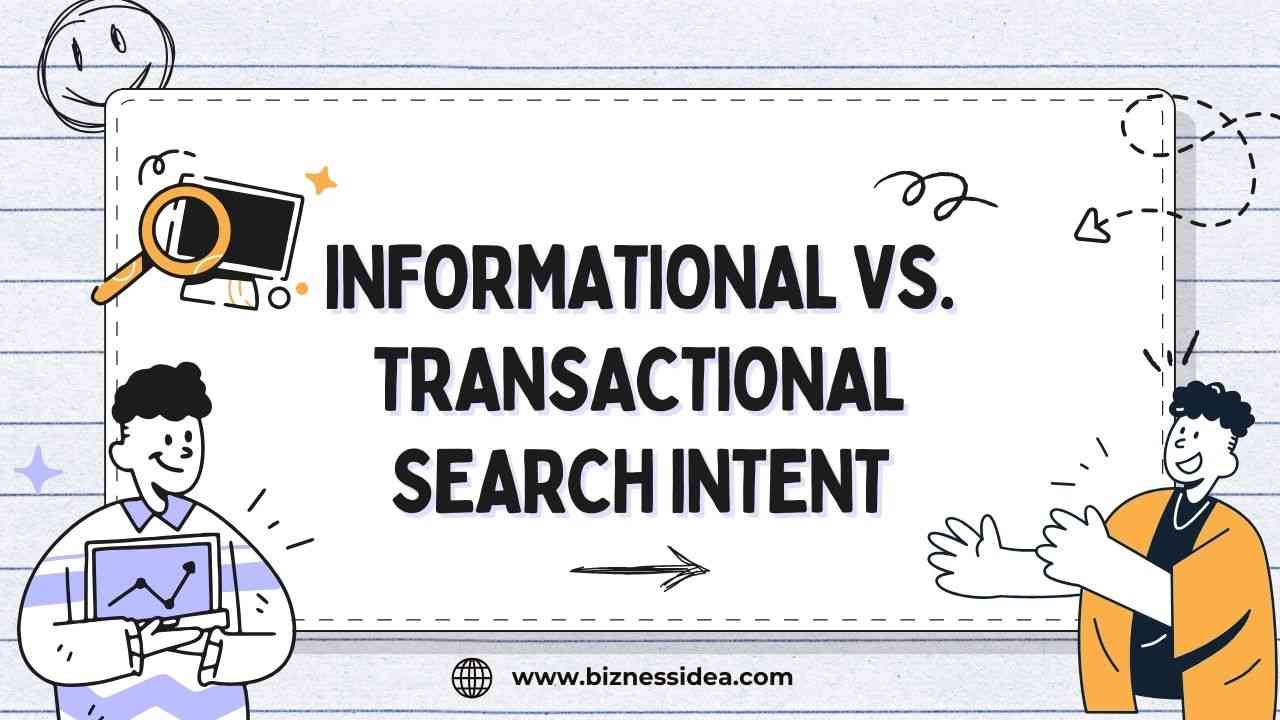intent behind every search query. Google’s algorithms are smarter, analyzing user behavior and context to deliver the most relevant results. For SEOs and digital marketers, this means focusing on search intent SEO rather than keyword stuffing. Among the different types of intent, informational and transactional stand out as the most impactful. One brings awareness, the other drives conversions. This article explains the differences, explores how to optimize for both, and provides practical strategies to ensure your content ranks effectively in today’s evolving search landscape.
What Is Search Intent in SEO?
Search intent in SEO is the purpose behind a user’s query. When someone types into Google, they have a goal: learning something, reaching a specific site, or making a purchase. Search engines analyze behavior, click-through rates, and engagement to match the right content. In 2025, user intent in SEO is more crucial than ever as algorithms prioritize intent-based content. If your blog or landing page doesn’t align with what the user wants, it won’t rank, no matter how well optimized. Aligning content with search intent SEO improves rankings, builds trust, and boosts conversions.
Types of Search Intent You Must Know
Informational Search Intent
Informational search intent is when users are primarily looking to learn, research, or understand a topic without any immediate intention to buy. This type of search often happens at the top of the funnel, where people ask questions, look for tutorials, or seek general information. For instance, queries like “How does blockchain work?” or “Tips for SEO keyword research” fall into this category. The best way to satisfy these searches is through well-researched blogs, detailed guides, or explanatory videos. By targeting informational search intent, businesses can attract a wide audience, build credibility, and establish themselves as trusted knowledge sources.
Navigational Search Intent
Navigational search intent occurs when users already know the brand, website, or product they want to reach but rely on search engines to get there quickly. For example, someone typing “Facebook login” or “Nike official store” isn’t exploring but trying to find a specific destination. This intent highlights the importance of strong brand presence and authority. SEOs must ensure that official websites rank above competitors or fraudulent sites by optimizing branded keywords, maintaining technical SEO, and using structured data. By managing navigational search intent effectively, businesses strengthen their online presence and make it easier for users to connect directly.
Transactional Search Intent
Transactional search intent is the most conversion-driven form of search, where users are ready to take action—whether that’s making a purchase, subscribing to a service, or signing up for an offer. Queries like “Buy iPhone 16 Pro online,” “Netflix subscription discount,” or “Order pizza near me” indicate that the user has already made up their mind and now needs the fastest route to fulfillment. To optimize for transactional search intent, SEOs should design persuasive landing pages with strong CTAs, secure checkout systems, and clear product descriptions. This intent represents bottom-of-funnel users, making it the most valuable for revenue generation.
Commercial Investigation Search Intent
Commercial investigation search intent sits between informational and transactional stages. Here, users are interested in buying but are still comparing, evaluating, and researching options before committing. Typical queries include “Best budget laptops 2025,” “Nike Air Zoom vs. Adidas Ultraboost,” or “Top SEO agencies near me.” To optimize for commercial search intent, SEOs should publish in-depth comparison articles, product reviews, testimonials, and buyer guides. This helps potential customers weigh their options while subtly positioning your brand as the superior choice. By addressing commercial investigation intent, businesses nurture trust and lead users toward conversion while staying present in the decision-making process.
Informational vs. Transactional Search Intent – Key Differences
Informational and transactional intents differ in purpose, audience stage, and content needs. Informational searches aim to educate, using queries like “What is content marketing?” whereas transactional searches aim to convert, with queries like “Hire a content marketing agency.” The former requires formats such as blogs, tutorials, and videos, while the latter thrives on landing pages, CTAs, and e-commerce listings. Understanding these differences allows SEOs to strategically align their content. A balanced approach ensures that a brand attracts traffic at the awareness stage while also capturing conversions, creating a complete funnel powered by SEO keyword intent strategies.
Why Understanding Search Intent Matters for SEO Success
Search engines like Google now prioritize intent over simple keyword matching. Their goal is to provide users with exactly what they are searching for, whether that is an in-depth article, a product page, or a video. When SEOs align content with user intent, they boost click-through rates, improve dwell time, and lower bounce rates because the content delivers value immediately. Misaligned content frustrates users, leading to poor engagement and rankings. In 2025, search intent SEO ensures businesses remain competitive by delivering the right content at the right stage of the customer journey, increasing both trust and conversions.
How to Optimize Content for Each Search Intent
Optimizing for Informational Intent
To optimize for informational intent, SEOs should focus on creating high-value, educational resources like detailed blog posts, tutorials, how-to articles, FAQs, and infographics. The content should be structured clearly with headings and subheadings for readability and include visuals like explainer videos or diagrams to simplify complex topics. Using question-based formats also helps capture featured snippets and “People Also Ask” results. The key is to provide direct, actionable answers without pushing sales aggressively. By doing this, businesses align with SEO keyword intent, build brand trust, and attract consistent organic traffic from top-of-funnel users seeking knowledge and guidance.
Optimizing for Transactional Intent
Optimizing for transactional intent means designing content that encourages immediate action. SEOs should create landing pages with concise, persuasive copy and strong CTAs like “Buy Now” or “Start Free Trial.” Product descriptions must highlight key benefits, features, and pricing transparently. Adding trust signals such as verified reviews, secure payment options, and limited-time offers enhances credibility. Mobile responsiveness and fast-loading pages are essential, as buyers expect seamless experiences. When transactional keywords are matched with optimized pages, businesses capture ready-to-convert users. Aligning SEO keyword intent with this stage directly increases revenue by turning high-intent searches into measurable conversions and customer acquisitions.
Optimizing for Commercial/Investigational Intent
To optimize for commercial or investigational intent, businesses should create content that bridges the gap between learning and buying. Users at this stage are actively comparing options, so formats like “vs.” articles, top-10 lists, case studies, and review-based blogs are highly effective. Providing honest, data-backed insights helps establish trust while positioning your product or service as the superior option. Including visuals such as comparison tables, charts, or testimonials further strengthens credibility. By targeting SEO keyword intent for commercial searches, you help users make informed decisions while guiding them closer to a transaction, making this stage vital for nurturing leads.
Real-Life Examples of Informational vs. Transactional Keywords
- Informational: “How to lose weight fast”
Transactional: “Buy weight loss supplements online” - Informational: “Best running shoes for flat feet”
Transactional: “Nike Air Zoom Pegasus 40 price”
Tools to Identify Search Intent Effectively
- Google SERP analysis: Study the first page results to understand intent.
- Semrush & Ahrefs keyword intent filters: Automatically categorize keywords by intent.
- AnswerThePublic: Generates questions and related queries to identify informational needs.
Common Mistakes SEOs Make With Search Intent
- Targeting transactional keywords with blogs: Leads to poor conversions.
- Ignoring SERP features: Featured snippets, People Also Ask, and video results reveal intent.
- Keyword stuffing without context: Ranking requires intent alignment, not keyword density.
Conclusion
Informational and transactional search intents serve different purposes but are equally valuable in SEO. Informational intent attracts top-funnel traffic, while transactional intent drives revenue.
In 2025, the SEOs who succeed will be those who strategically align keyword intent with content format. Whether you’re building awareness or driving sales, the key is understanding intent, crafting the right content, and leveraging tools to analyze SERPs effectively.
By mastering search intent SEO, businesses can balance authority-building with revenue generation.
FAQs
Que 1. What is the difference between informational and transactional search intent?
Ans. Informational intent focuses on learning, while transactional intent focuses on buying or completing an action.
Que 2. Which type of intent is best for SEO?
Ans. Both matter—informational intent builds brand authority, while transactional intent drives sales. A balanced strategy works best.
Que 3. How do I know the user search intent behind a keyword?
Ans. Analyze SERP results. If you see blogs and guides, it’s informational. If you see product pages or CTAs, it’s transactional.
Que 4. Can one keyword have multiple intents?
Ans. Yes. Some queries show mixed intent, meaning Google displays both blogs and product pages. Optimizing for both may be effective.
Que 5. What role do tools like Semrush play in identifying intent?
Ans. They categorize keywords by intent and help SEOs create content tailored to user goals.













